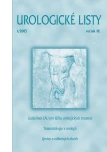-
Medical journals
- Career
OPTIMAL METHOD OF INTRAABDOMINAL PRESSURE MEASUREMENT
Authors: doc. MUDr. Michal Mašek, CSc.; MUDr. Vítězslav Ruber; MUDr. Václav Rak; MUDr. Daniel Ira
Authors‘ workplace: oddělení úrazové chirurgie LF MU a FN Brno
Published in: Urol List 2005; 3(1): 53-55
Overview
The measurement of intraabdominal pressure is very important investigation to make early diagnosis of impending abdominal compartment syndrome. We perform it on the intensive care units every time when the increasing of intraabdominal pressure is suspected.
In accordance with the dynamic of measured values we can indicate to make timely decompression of abdominal cavity.
The paper is based on our own clinical experiences - about 50 measurements per one year.
We do monitoring of intraabdominal pressure according to Whitesides by means of urinary bladder catheterization with filling up to 50 ml of physiologic solution. The reason was to eliminate mistakes which are made by the capacity decreasing pathology of urinary bladder.
We use the horizontal laparostoma for decompression of the abdominal cavity by means of temporary closure by Ethizip.
The correct interpretation of results of measurement and timely indicated decompression can significantly decrease the risk of multiorgan failure.KEY WORDS:
intraabdominal pressure, compartment syndrome, monitoring of intraabdominal pressure, laparostoma
Sources
1. Burch JM et al. The abdominal compartment syndrome. Surg Clin of North Africa 1996; 76 : 833-841.
2. Ertel W et al. Das abdominale Kompartment Syndrom nach schwerem Bauch - oder Beckentrauma. Langenbecks Arch Chir 1998; 115 : 1189-1190.
3. Gudmundsson FF et al. Comparsion od different methods for messuring intra-abdominal pressure. Int Care Med 2002; 28 : 509-513.
4. Hardaway RM. Traumatic and septic schock alias post trauma critical illness. Brit J Surg 1998; 85 : 1473-1490.
5. Mayberry JC et al. Prevention of abdominal compartment syndrome by absorbable mesh prosthetic, closure. Arch Surg 1997; 132 : 957-961.
6. Michek J et al. Pánevní kompartment syndrom. Úraz Chir 2000; 8 : 24-29.
7. Michek J et al. Existuje pánevní kompartment - Naše zkušenosti. Rozh chir 2001; 568-570.
8. Pleva L, Mayzlík J, Ječmínek V. Komplikované zlomeniny a kompartement syndrom u polytraumat. Úraz Chir 2000; 4 : 4-11.
9. Pribelský M, Pechan J, Hupková H, Pinïák D. "One shot" antibiotická profylaxia v brušnej chirurgii. Bratisl Lek List 1999; 100(12); 697-699.
10. Růžička M, Dítě P, Simonová H, Veverková L. Venous complications in the treatment of chronic and acute pancreatitis. In: Raymond-Martimbeau P, Prescott R, Zummo M (eds). Phlebology 92. Paris: John Libbey Eurotext 1992 : 1177-1179.
11. Schumpelick V et al. Minimierte Polypropylen-Netze zur praeperitonealen Netzplastik (PNP) der Narbenhernie, Der Chirurg 1999; 70 : 422.
12. Tons C et al. Abdominelles Kompartement syndrom - Vermeidung und Behandlung. Der Chirurg 2000; 70 : 918-926.
13. Tiwary A et al. Acute compartment syndromes. British J of Surg 2002; 89 : 397-412.
14. Vokurka J, Wechsler J, Čapov I, Žák J. Faktory ovlivňující laparoskopický operační výkon. Bulletin HPB chirurgie 1993; 1 : 7.
15. Žák J, Jedlička V, Korbička J, Vlček P. Možnosti ovlivnění výživy u akutní nekrotické pankreatitidy. Metabolické a výživové dny. Sborník prací. Hradec Králové 1999 : 34.
Labels
Paediatric urologist Urology
Article was published inUrological Journal

2005 Issue 1-
All articles in this issue
- PRESENT VIEW OF URETERAL INJURIES
- RENAL TRAUMA AND THE PRESERVATION OF RENAL PARENCHYMA
- BLADDER TRAUMA
- URETHRAL TRAUMA IN MALES - IMMEDIATE AND DELAYED TREATMENT
- INJURIES TO THE EXTERNAL GENITAL ORGANS
- TRAUMA OF INERVATION OF LOWER URINARY TRACT
- BLOOD CARE AT ELECTIVE UROLOGICAL OPERATIONS
- OPTIMAL METHOD OF INTRAABDOMINAL PRESSURE MEASUREMENT
- STRESS URINARY INCONTINENCE IN WOMEN AND ITS PHARMACOLOGIC TREATMENT OPTIONS
- Urological Journal
- Journal archive
- Current issue
- Online only
- About the journal
Most read in this issue- OPTIMAL METHOD OF INTRAABDOMINAL PRESSURE MEASUREMENT
- INJURIES TO THE EXTERNAL GENITAL ORGANS
- URETHRAL TRAUMA IN MALES - IMMEDIATE AND DELAYED TREATMENT
- BLADDER TRAUMA
Login#ADS_BOTTOM_SCRIPTS#Forgotten passwordEnter the email address that you registered with. We will send you instructions on how to set a new password.
- Career

